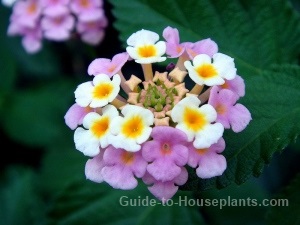





Botanical Name: Lantana camara
Colorful flower clusters have long made lantana plants a favorite for flower beds and borders. Their scented blossoms are attractive to butterflies, too, if you choose to move lantana to your porch or patio for the summer.
Lantanas are evergreen, but frost-tender. Bring your potted lantana plants indoors when the temperature drops in autumn, and you'll enjoy them for many more months.
Flower clusters, called umbels, are available in a range of yellow, orange, red, white, pink, lavender and purple.
Two or three colors are often present on each flower head with the flower buds opening in succession from the outside ring toward the center.
The ovate, toothed leaves are dark-green and deeply veined. Lantana leaves are slightly toxic, so take care when growing these flowers, lantana can cause illness if ingested. Another caution: this plant is fast-growing and can be invasive if grown in the garden. That's another good reason to grow it in a pot.
Pinch and prune. Pinch off growing tips to keep lantana compact and to encourage branching. Some cultivars are compact and may not need pinching at all. Pruning lantana in late winter will bring more blooms. Cut stems back to about 5 in (13 cm).
Deadhead spent blooms to encourage more flowers. You can keep your lantana blooming nearly year-round as long as it gets enough sunlight.
Repot in spring when the roots are growing through the bottom of the pot. Move up to a pot only 1 size larger. Lantana flowers best when slightly pot-bound.
Watch for whiteflies that like to attack lantana plants. You'll find these tiny, white moth-like insects lurking under leaves. Get rid of whiteflies as soon as you notice them because they multiply quickly.

Origin: Central and South America
Height: Up to 6 ft (1.8 m); Easily kept to 1 ft (30 cm) indoors with regular pinching and pruning lantana.
Light: Bright light to full sun.
Water: Keep soil evenly moist, not soggy spring through fall; slightly drier in winter. Established plants will tolerate drier soil.
Humidity: Moderate to high room humidity. Stand plant on a tray of wet pebbles to increase humidity.
Temperature: Normal room temperatures 60-75°F/16-24°C. Lantanas are cold-hardy to USDA Zone 9, if you put them outdoors.
Soil: Peat moss based potting mix that drains well.
Fertilizer: Feed every 2 weeks with a balanced liquid fertilizer diluted by half while plant is growing.
Propagation: Take stem tip cuttings in spring or early summer. They'll root easily in moist soil. Lantana seeds are easy to germinate. If you want to collect seeds from your plant, allow some flowers to go to seed in the fall. Store seeds in a cool, dry place then sow them indoors in early spring.
Copyright © www.100flowers.win Botanic Garden All Rights Reserved